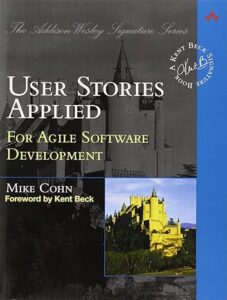User Story Definition
A User Story is a short description of something that the user of the product needs or wants. It is written from the perspective of the user and this is the essence:
- Simple and Brief – A User Story is typically a few sentences long. It states what the user needs or wants and why. Example: “As an online shopper, I want to be able to filter my purchases by price, so that I can quickly find products within my budget.”
- Goal – The goal of a User Story is to clarify what needs to be done, but not necessarily how. It gives the Scrum Team the freedom to find the best solution.
The Scrum Guide does not specifically talk about User Stories but they fit well in an Agile environment. This is because they ensure that everyone understands what the user needs.
Widely read book: User Stories Applied
 A well-known work on writing User Stories is “User Stories Applied: For Agile Software Development“. The book is written by Mike Cohn because many teams struggle with describing the work that needs to be done. It tells you everything you need to know to use User Stories effectively:
A well-known work on writing User Stories is “User Stories Applied: For Agile Software Development“. The book is written by Mike Cohn because many teams struggle with describing the work that needs to be done. It tells you everything you need to know to use User Stories effectively:
- What is a User Story – Cohn explains what User Stories are and why they are valuable in Agile environments. He highlights their role in fostering communication and focusing on user needs.
- How to write good User Stories – The book provides detailed guidelines on how to write effective User Stories. For example, by formulating a Story concisely and focusing on the needs of the user.
- INVEST Principle – Cohn introduces the INVEST principle: Independent, Negotiable, Valuable, Estimable, Small and Testable. It is a checklist to ensure the quality of User Stories.
- Acceptance criteria – The book discusses the importance of clear acceptance criteria for each User Story. This helps to define when a Story is completed.
- Prioritizing and Planning – It explains how to prioritize User Stories in the Product Backlog and schedule them in Sprints. It also explains how to deal with changing requirements.
- Estimation and Planning Poker – Cohn also covers techniques for estimating the size of User Stories, including Planning Poker. This is a popular method for estimating the effort required.
- Use in Practice – The book includes many practical examples and case studies that show how to effectively use User Stories in different scenarios.
